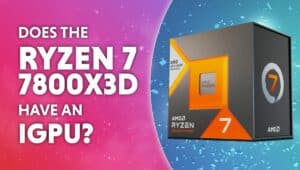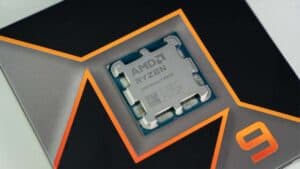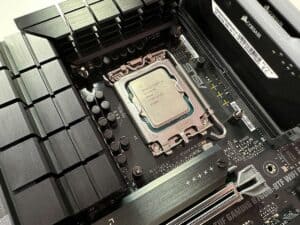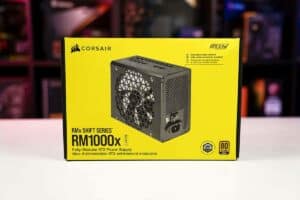Is the Ryzen 9 7950X3D good?
Is the Ryzen 9 7950X3D as good as AMD makes it out to be?

WePC is reader-supported. When you buy through links on our site, we may earn an affiliate commission. Prices subject to change. Learn more
Is the Ryzen 9 7950X3D good? AMD’s next flagship, the Ryzen 9 7950X3D, is expected to be released in February 2023, according to their recent announcement at CES.
Now read: AMD announces Ryzen 7000 series 3D V-cache CPUs at CES 2023
The 7950X3D will be equipped with V-cache technology, a much-needed upgrade that will allow it to trade blows with Intel’s flagship, the i9-13900KS.
We now know the processor’s official specs and have some benchmarks to give us a better idea of its performance. The upcoming X3D flagship processor may be able to dethrone a one-month-old special edition i9.
Let’s find out how good the Ryzen 9 7950X3D really is.
Ryzen 9 7950X3D: AMD’s next flagship
First of all, here are the Ryzen 9 7950X3D’s specs.
- Core count: 16
- Thread count: 32
- Base clock: 4.2GHz
- Boost clock: 5.7GHz
- L2 cache: 16MB – 1MB per core
- L3 cache: 128MB
- TDP: 120 watts
- iGPU: Radeon Graphics
- Socket: AM5
The 128MB L3 cache and 144MB combined (L2+L3) cache means the Ryzen 7950X3D will have the most cache ever seen in consumer-grade processors, followed closely by the 7900X3D at an equally impressive 140MB combined cache.
It’s kind of crazy if you think about it. Many server and workstation processors don’t have that much cache.
Is the Ryzen 9 7950X3D good?
The X3D CPU series targets gamers as its primary audience.
That’s because games benefit the most from having such a high L3 cache: the processor can avoid having to access the much slower RAM too often and can dedicate time saved to producing more frames.
And, of course, for a gamer, on-screen framerate is the definitive metric for measuring performance.
AMD showed us several self-tested benchmarks at CES. The Ryzen 9 7950X3D is shown to outperform the Intel i9-13900K (not the KS, mind you) by a margin of 9 to 24% across various games.
Whether or not this reflects the new Ryzen’s real-world performance remains up for debate, but it’s clear that AMD isn’t pulling any punches this time around.
Excellent Multicore Performance
The Ryzen 9 7950X3D manages to keep the high core and thread count of its X-version processor.
With 32 threads that can operate at around 5GHz concurrently, this processor will make quick work of any productivity-related task thrown at it.
It’s clear why AMD considers this CPU to be the very best – not only for gamers, but also for content creators.
High Boost Clock
V cache is very temperature sensitive, so AMD had to lower max boost clocks in the Zen 3 Ryzen 7 5800X3D and the more recent Zen 4 7800X3D to prevent overheating.
Interestingly, the Ryzen 9 7950X3D retains the 5.7GHz boost clock offered by its X-version, which means gamers can now get high-end single-thread performance all while enjoying the benefits of V-cache.
Single-thread performance is very important in games, so this is great news.
Power efficiency
The Ryzen 9 7950X3D appears to be incredibly power efficient on paper. At a base TDP of 120 watts, it looks like AMD has hit the sweet spot between their light 65-watt Zen 3 processors and the power-hungry 170-watt processors we saw in Q4 2022.
This power optimization also affords the CPU much better thermals. Throttling won’t be a noticeable problem with a half-decent cooling solution.
Double CCDs
AMD has had to employ a double CCD structure to retain the CPU’s high boost clock. In lay terms, the processor consists of two chiplets.
One of the two houses the V-cache, allowing the other to go all out with AMD’s precision boost. This intelligent design allows the CPU to feature V-cache without compromising its boost clock.
This innovation may have some drawbacks, though, since the chiplet that doesn’t have V-cache built onto it will have a slower access time, which could result in lag spikes.
AMD is working with Microsoft to optimize Windows Scheduler to counter this problem through the smart assignment of tasks to the threads best suited to complete them.
We’ll just have to wait and see how things actually are when the processor hits the market.
Is the Ryzen 9 7950X3D worth it?
The value of the new X3D CPUs is yet to be determined, but we can make a reasonable estimation.
The Ryzen 9 7950X3D will be a strong competitor to Intel and the Ryzen 9 7950X. The incorporation of the 3D V-cache onto the CPU package, along with its smart placement on only one of the two CCDs, will contribute to its superiority. This allows the 3D V-cache to enhance single-core performance without hindering the entire CPU, as was the case with the 5800X3D. Consequently, the CPU is ideal for single-core tasks like gaming and is less restrictive on multi-core tasks due to only half of the CPU containing the 3D V-cache.
However, the 3D V-cache is sensitive to temperature and voltage fluctuations, and this has limited the overclocking capabilities of previous models like the 5800X3D. Fortunately, as only half of the CPU cores contain the 3D V-cache, this issue is not as severe. Although manual overclocking is still not possible, the new technology does offer a fully functional automatic boost from BPO and Curve optimizer.
In conclusion, we believe that the new 7000X3D processors, especially the 7950X3D, will be worth it, at least in comparison to the previous generation.
How does AMD’s 3D V-cache boost gaming performance?
AMD’s 3D V-cache is a new technology that adds a 64MB on-die cache to its Ryzen 7000 and 5000 series processors. This cache is built using a new 3D stacking technique that allows the cache to be physically closer to the processor cores, reducing the distance data has to travel and thus reducing latency.
By adding this on-die cache, AMD has significantly increased the amount of high-speed memory available to the processor, which can lead to improved performance in gaming and other applications that benefit from high-speed memory. Specifically, the increased cache can help reduce the number of times the processor needs to access slower system memory, improving the overall efficiency and speed of the processor.
While the exact impact of the 3D V-cache on gaming performance will depend on a number of factors, including the specific game being played and the rest of the system configuration, early benchmarks have shown that the technology can lead to significant performance gains in some scenarios.











